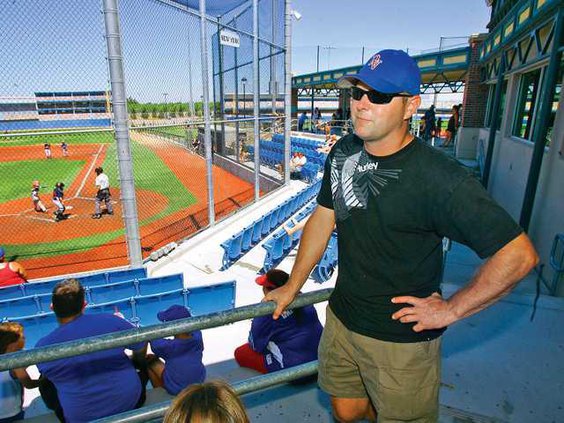Big League Dreams in August of 2013 will start doing something that no other park does in Manteca. The sports complex will start generating more than $250,000 a year for the distressed municipal general fund.
But as far as City Manager Steve Pinkerton is concerned, Manteca is already financially ahead.
That’s because the city is avoiding $500,000 a year it would cost to maintain and operate a sports complex with six softball fields minus the soccer arena, two restaurants, and all of the upgrades that make the complex appealing.
The city-owned complex was designed and is being operated and maintained for 35 years by BLD. It reaches a five-year milestone in October. That month will mark the first official game at the complex.
The fight over whether Manteca should even have a BLD lasted seven years from start to finish making it the longest running political brawl in municipal history. It included regular marathon council meetings that typically lasted six hours with some going on for nine hours. It prompted a criminal investigation when then Councilwoman Denise Giordano accused a BLD partner of threatening her by point a finger at her just before 3 a.m. during one particularly heated council meeting. The District Attorney’s office investigated and declined to file charges.
The initial furor was created over the first site proposed at Woodward Park. The city, at the time, lacked the funds to develop Woodward Park. Council members saw the private-public partnership with BLD as an effective way to do so. Neighbors didn’t want traffic, night games, and crowd noises.
Ultimately the location was switched to surplus municipal wastewater plant land where the city could use redevelopment agency funds to build the complex. That in turn freed up park fees to start development of Woodward Park.
Lathrop sued to stop BLD complex
Then, just as Manteca politics settled down, Lathrop slapped a suit against the project as well as the accompanying Stadium Retail Center claiming the two would generate excessive surface traffic on streets in that community. That delayed the start of both the retail and BLD complexes for close to a year. Meanwhile cement and steel prices shot up adding $5 million to the complex’s price tag that ended up costing more than $30 million to build.
There was also opposition from a group that had been championing private sector firms taking over the municipal wastewater treatment plant the city had already built but didn’t like the idea Manteca would finance the park.
Some critics zeroed in on the fact RDA borrowed money to build the park. Yet if the city did it outside of the RDA boundaries they would have had to borrow funds in a manner that required them to be repaid from the general fund if adequate revenue did not come in from the BLD complex.
City parks in California are typically built by borrowing, money, using park fees paid by growth or a combination of the two.
This way, users are basically picking up the entire tab of running, managing and maintaining the sports complex. At the same time, BLD has to replace anything that wears out on their dime whether it is seating, light standards, roofs, netting, turf, or the parking lot asphalt.
Initially municipal rank-and-file recreation staff was leery of the project. But even they conceded that a company driven by profit and the need for return business had the motivation to aggressively book teams and tournaments as well as cater more effectively to the needs of players.
BLD paid Manteca $325,000 in 2010
BLD paid Manteca $325,000 in 2010. That covers the basic rent based on gross income. It also includes two other payments BLD is required to make every year - $40,000 and $26,500 for the cost of adding on two features after the original contract was awarded to build the complex. Those features were the indoor soccer arena and all-weather turf for all six baseball infields that were not included in the original BLD project. Those payments are reimbursing 100 percent of the cost of the two projects to the bonus bucks account that represents fees paid by developers of residential sewer allocation certainty and park fees collected on new homes for community facilities.
The basic rent - that came to $271,000 - is going toward reimbursing the park fee account. By the time it is paid off in August of next year, over $1 million will have been returned to be used to build other recreation facilities in Manteca. No other park has done that either.
Once the park fees are paid back, the basic rent of $270,000 plus will go straight to the general fund.
That - combined with the annual avoidance of $500,000 that it would have cost the city to manage and run leagues plus maintain and replace components as they wore out at the facility - will have a positive impact of $770,000 on the city’s general fund.
“We would have had to pay for the upkeep and to run it if it had been a traditional (six-field) sports complex,” Pinkerton said.
At $271,000 a year after the park fees are paid off, that means the city’s general fund would receive $9.4 million on top of the city not having to pay $17.5 million in maintenance over 35 years.
Some critics have said that the figure of just $27 million doesn’t cover the $30 million cost. Proponents have countered that if the city had built a sports complex like Tracy’s they may have paid less - the tab would have been $18 million without the indoor arena, two restaurants, and numerous upgrades. However, the city wouldn’t have collected any revenue to offset the cost of building the complex. They also would have been on the hook to maintain the complex.
“It’s a big success no matter how you look at it,” Pinkerton said.





